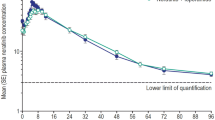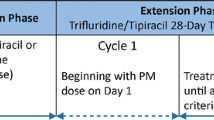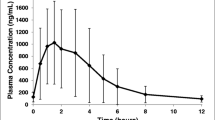Summary
The pharmacokinetics of orally-administered didanosine were evaluated in 6 male and 6 female HIV seropositive patients to determine the effect of pretreatment with metoclopramide, an inducer of gastrointestinal motility, and loperamide, which retards motility. Using a randomized, balanced, crossover design, each patient received the following three treatments under fasting conditions: didanosine as a single agent, didanosine 5 min after a single 10 mg intravenous dose of metoclopramide, and didanosine 1 h after the final of 4 doses, 4 mg each, of loperamide. Serial blood and urine samples were collected for up to 12 h after each dose. Plasma and urine aliquots were analysed for intact didanosine using HPLC with UV detection. Pharmacokinetic parameter values were calculated using noncompartmental methods.
The mean Cmax values were significantly greater for the didanosine single agent (2.04 μg·ml−1) and didanosine with metoclopramide (2.30 μg·ml−1) treatments than for the combination of didanosine with loperamide (1.57 μg·ml−1). The t1/2 in males was significantly greater than in females for the didanosine (1.75 vs 1.12 h, respectively) and didanosine with metoclopramide treatments (1.74 vs 1.20 h, respectively). No significant treatment or gender effects were observed for AUC or UR (urinary recovery).
The pharmacokinetics of didanosine were not altered appreciably by dosing with metoclopramide. Administration with loperamide affected the rate but not the extent of absorption. There were no clinically relevant differences between males and females in the disposition of didanosine.
Similar content being viewed by others
References
Knupp CA, Shyu WC, Dolin R, Valentine FT, McLaren C, Martin RR, Pittman KA, Barbhaiya RH (1991) Pharmacokinetics of didanosine in patients with acquired immunodeficiency syndrome or acquired immunodeficiency syndrome-related complex. Clin Pharmacol Ther 49: 523–535
Hartman NR, Yarchoan R, Pluda JM, Thomas RV, Marczyk KS, Broder S, Johns DG (1990) Pharmacokinetics of 2',3'-dideoxyadenosine and 2',3'-dideoxyinosine in patients with severe human immunodeficiency virus infection. Clin Pharmacol Ther 47: 647–654
Anderson BD, Wygant MB, Xiang TX, Waugh WA, Stella VJ (1988) Preformulation solubility and kinetic studies of 2',3'-dideoxynucleosides: potential anti-AIDS agents. Int J Pharm 45: 27–37
Knupp CA, Shyu WC, Morgenthien EA, Lee JS, Barbhaiya RH (1993) Biopharmaceutics of didanosine in humans and in a model for acid labile drugs, the pentagastrin-pretreated dog. Pharm Res 10: 1157–1164
Kilbinger H, Weihrauch TR (1982) Drugs increasing gastrointestinal motility. Pharmacology 25: 61–72
Heel RC, Brogden RN, Speight TM, Avery GS (1978) Loperamide: a review of its pharmacological properties and therapeutic efficacy in diarrhoea. Drugs 15: 33–52
Knupp CA, Stancato FA, Papp EA, Barbhaiya RH (1990) Quantitation of didanosine in human plasma and urine by high performance liquid chromatography. J Chromatogr 533: 282–290
Prescott P (1975) An approximate test for outliers in linear models. Technometrics 17: 129–134
Gibaldi M, Perrier D (1982) Noncompartmental analysis based on statistical moment theory. In: Gibaldi M, Perrier D (eds) Pharmacokinetics, 2nd edn. Dekker, New York
Riegelman S, Collier P (1980) The application of statistical moment theory to the evaluation of in vivo dissolution time and absorption time. J Pharmacok Biopharm 8: 509–534
Winer BJ (1971) Statistical principles in experimental design, 2nd edn. McGraw-Hill, New York
Conover WJ, Iman RL (1981) Rank transformations as a bridge between parametric and nonparametric statistics. Am Statis 35: 124–133
Gill JL (1978) Design and analysis of experiments in the animal and medical sciences, vol 1. The Iowa State University Press, Iowa
Kramer CY (1956) Extension of multiple range tests to group means with unequal numbers of replications. Biometrics 12: 307–310
Snedecor GW, Cochran WG (1980) Statistical methods, 7th edn. The Iowa State University Press, Iowa
Schiller LR, Santa Ana CA, Morawski SG, Fordtran JS (1984) Mechanism of the antidiarrheal effect of loperamide. Gastroenterology 86: 1475–1480
Ooms LAA, Degryse AD, Janssen PAJ (1984) Mechanisms of action of loperamide. Scan J Gastroenterol Suppl 96: 145–155
Sninsky CA, Davis RH, Clench MH, Thomas KD, Mathias JR (1986) Effect of lidamidine hydrochloride and loperamide on gastric emptying and transit of the small intestine. Gastroenterology 90: 68–73
Bryson JC, Dukes GE, Kirby MG, Heizer WD, Powell JR (1989) Effect of altering small bowel transit time on sustained release theophylline absorption. J Clin Pharmacol 29: 733–738
Shyu WC, Knupp CA, Pittman KA, Dunkle L, Barbhaiya RH (1991) Food-induced reduction in bioavailability of didanosine. Clin Pharmacol Ther 50: 503–507
Brunetto AL, Pearson ADJ, Gibson R, Bateman DN, Rashid MU, Laker MF (1990) The effect of pharmacological modification of gastric emptying and mouth-to-caecum transit time on the absorption of sugar probe marker molecules of intestinal permeability in normal man. Eur J Clin Invest 20: 279–284
Holgate AM, Read NW (1983) Relationship between small bowel transit time and absorption of a solid meal. Influence of metoclopramide, magnesium sulfate and lactulose. Dig Dis Sci 28: 812–819
McEvoy GK (1993) Metoclopramide. In: American Hospital Formulary Service Drug Information. American Society of Hospital Pharmacists, Maryland
Nimmo J, Heading RC, Tothill P, Prescott LF (1973) Pharmacological modification of gastric emptying: effect of propantheline and metoclopramide on paracetamol absorption. Br Med J 1: 587–589
Shukla UA, Pittman KA, Barbhaiya RH (1992) Pharmacokinetic interactions of cefprozil with food, propantheline, metoclopramide, and probenecid in healthy volunteers. J Clin Pharmacol 32: 725–731
Nimmo J (1973) The influence of metoclopramide on drug absorption. Postgrad Med J 49 [Suppl 4]: 25–29
Manninen V, Melin J, Apajalahti A, Karesoja M (1973) Altered absorption of digoxin in patients given proprantheline and metoclopramide. Lancet I: 398–399
Yuen GJ, Hansten PD, Collins J (1987) Effect of metoclopramide on the absorption of an oral sustained-release quinidine product. Clin Pharmacol 6: 722–725
Author information
Authors and Affiliations
Rights and permissions
About this article
Cite this article
Knupp, C.A., Milbrath, R.L. & Barbhaiya, R.H. Effect of metoclopramide and loperamide on the pharmacokinetics of didanosine in HIV seropositive asymptomatic male and female patients. Eur J Clin Pharmacol 45, 409–413 (1993). https://doi.org/10.1007/BF00315510
Received:
Accepted:
Issue Date:
DOI: https://doi.org/10.1007/BF00315510




